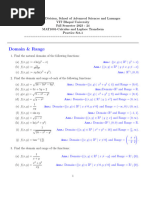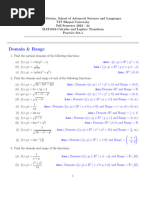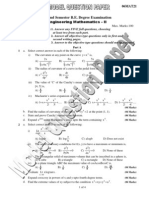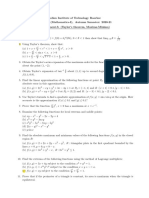Assignment 1
Uploaded by
Roop KishorAssignment 1
Uploaded by
Roop KishorMAT1001 (Calculus and Laplace Transform)
Assignment - 1
1. Show that the following limit does not exist.
(
xy
2 if (x, y) 6= (0, 0)
f (x, y) = x−y
0 if (x, y) = (0, 0)
2. Let (
x2 y 2
x2 +y 2
if (x, y) 6= (0, 0)
f (x, y) =
0 if (x, y) = (0, 0)
then show that
fxy (0, 0) = fyx (0, 0).
3. Show that if w = f (u, v) satisfies the equation fuu +fvv = 0 and if u = (x2 − y 2 ) /2
and v = xy, then w satisfies the equation wxx + wyy = 0.
4. Find the maximum and minimum values for the function
f (x, y) = x2 + 2bxy + y 2 ,
where b is some real number.
5. Find the absolute maximum and minimum values for the function
f (x, y) = 4x2 + 2y 2 + 4xy − 10x − 2y − 3
over the rectangle: 0 ≤ x ≤ 3 and −4 ≤ y ≤ 2.
6. Use the method of Lagrange’s multipliers to show that the rectangular solid of
maximum volume that can be inscribed in a sphere is a cube.
1
7. Using Taylor’s formula to find quadratic approximation of f (x, y) = 1−x−y+xy
about origin.
8. Find by double integration the area enclosed by the pair of curves y = 2 − x and
y 2 = 2(2 − x)
9. Change the order of integration and evaluate
ˆ a ˆ a−√a2 −y2
xy ln(x + a)
dxdy.
0 0 (x − a)2
10. Evaluate the following integrals by changing it into an equivalent polar form:
ˆ ln 2 ˆ √(ln 2)2 −y2 √
2 2
e x +y dxdy.
0 0
You might also like
- A11+A12+A13 - MAT1001 - Calculus and Laplace Transformation - Winter 2022-23 (Offline) - MID TERMNo ratings yetA11+A12+A13 - MAT1001 - Calculus and Laplace Transformation - Winter 2022-23 (Offline) - MID TERM1 page
- Term End Examination - May 2013 Course: MAT101 - Multivariable Calculus and Differential Equations Slot: F2+TF2 Class NBR: 3461 Time: Three Hours Max - Marks:100No ratings yetTerm End Examination - May 2013 Course: MAT101 - Multivariable Calculus and Differential Equations Slot: F2+TF2 Class NBR: 3461 Time: Three Hours Max - Marks:1002 pages
- Tutorial 6 - Maxima Minima and Taylor SeriesNo ratings yetTutorial 6 - Maxima Minima and Taylor Series2 pages
- Bachelor'S Degree Programme (BDP) Term-End Examination June, 2017No ratings yetBachelor'S Degree Programme (BDP) Term-End Examination June, 20174 pages
- Department of Mathematics and Natural Sciences MAT 110 Final Assignment SPRING 2021 SET: 1 (AFE)No ratings yetDepartment of Mathematics and Natural Sciences MAT 110 Final Assignment SPRING 2021 SET: 1 (AFE)2 pages
- AMA 1101 Assignment 1: Due: Friday, September 27, 2013 On Class. It Is 1% of The Final MarkNo ratings yetAMA 1101 Assignment 1: Due: Friday, September 27, 2013 On Class. It Is 1% of The Final Mark1 page
- Mid Term Examination-2021: Semester-1 Time: 1 Hour Max Marks: 20No ratings yetMid Term Examination-2021: Semester-1 Time: 1 Hour Max Marks: 201 page
- Factoring and Algebra - A Selection of Classic Mathematical Articles Containing Examples and Exercises on the Subject of Algebra (Mathematics Series)From EverandFactoring and Algebra - A Selection of Classic Mathematical Articles Containing Examples and Exercises on the Subject of Algebra (Mathematics Series)No ratings yet
- VIT Bhopal University MAT1003 Calculus TEE E11+E12+E14No ratings yetVIT Bhopal University MAT1003 Calculus TEE E11+E12+E142 pages
- NIIT University MAT 101 Tutorial Sheet 2 Differential Equations AnswersNo ratings yetNIIT University MAT 101 Tutorial Sheet 2 Differential Equations Answers2 pages
- Indian Institute of Technology Bhubaneswar School of Basic Sciences Mathematics-1 (MA1L001) (Autumn-2019) Assignment-4No ratings yetIndian Institute of Technology Bhubaneswar School of Basic Sciences Mathematics-1 (MA1L001) (Autumn-2019) Assignment-42 pages
- VIT Bhopal University MAT1003 Calculus TEE D21+D22+D23No ratings yetVIT Bhopal University MAT1003 Calculus TEE D21+D22+D232 pages
- (T) (5cos 5 Sin) I (5sin 5 Cos) J, 0.: R T T T T T T TNo ratings yet(T) (5cos 5 Sin) I (5sin 5 Cos) J, 0.: R T T T T T T T15 pages
- Assignment-II_MAS1001_Calculus_and_Matrices[1]No ratings yetAssignment-II_MAS1001_Calculus_and_Matrices[1]2 pages
- School of Advanced Sciences Department of Mathematics: Answer All The QuestionsNo ratings yetSchool of Advanced Sciences Department of Mathematics: Answer All The Questions4 pages
- Final Assessment Test - November 2016: Course: Class NBR(S) : Slot: Time: Three Hours Max. Marks: 100No ratings yetFinal Assessment Test - November 2016: Course: Class NBR(S) : Slot: Time: Three Hours Max. Marks: 1002 pages
- Previous Years Questions (2020-1983) Segment-Wise: Ordinary Differential EquationsNo ratings yetPrevious Years Questions (2020-1983) Segment-Wise: Ordinary Differential Equations16 pages
- VIT Bhopal University MAT1003 Calculus TEE B21+B22+B23No ratings yetVIT Bhopal University MAT1003 Calculus TEE B21+B22+B232 pages



























































